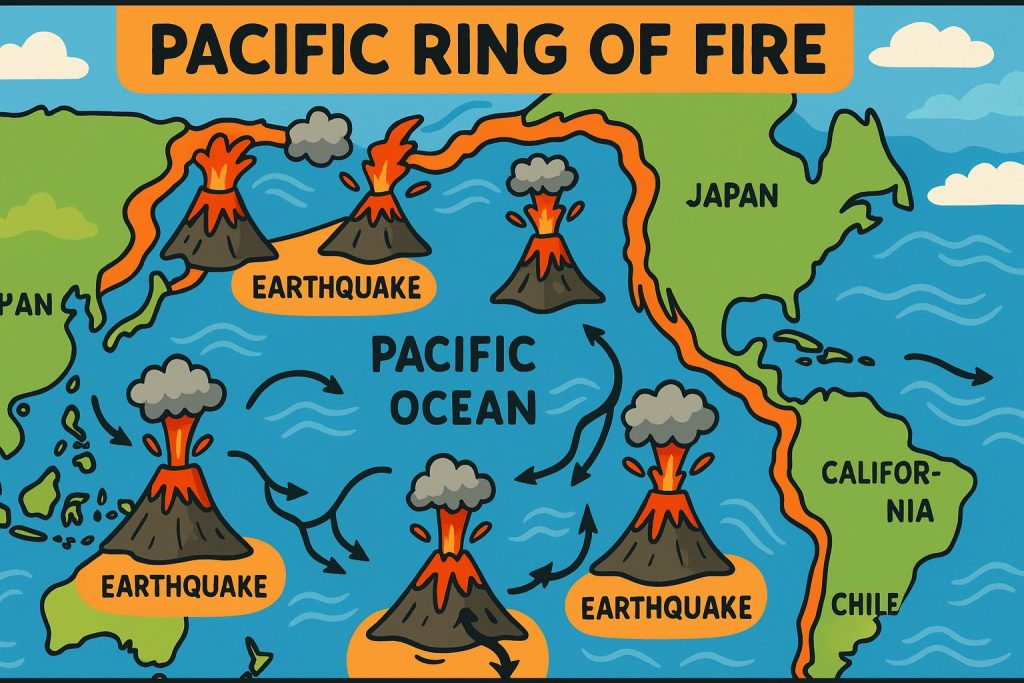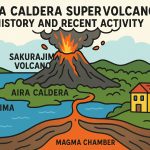The Pacific Ring of Fire is a horseshoe-shaped belt of intense seismic and volcanic activity that surrounds the Pacific Ocean basin. It stretches for over 40,000 kilometers, touching countries like Japan, Indonesia, the Philippines, New Zealand, Papua New Guinea, Chile, Mexico, the United States (especially Alaska and the West Coast), and Russia’s Kamchatka Peninsula.
This region is home to:
- Around 75% of the world’s active volcanoes
- About 90% of all earthquakes globally
- Multiple tectonic plate boundaries, including subduction zones and transform faults
The intense activity in this zone is caused by the constant movement of tectonic plates — particularly as oceanic plates sink (subduct) beneath continental plates, producing deep earthquakes and powerful volcanic eruptions.
Why Is It So Dangerous?
Because the Ring of Fire is so geologically active, it’s responsible for some of the deadliest natural disasters in modern history:
- The 2004 Indian Ocean earthquake and tsunami (though slightly outside the Ring’s core)
- The 2011 Tōhoku earthquake and tsunami in Japan
- The 1985 Nevado del Ruiz eruption in Colombia
- Frequent eruptions of Mount Merapi, Sakurajima, Popocatépetl, and Mount St. Helens
Many cities and millions of people live in close proximity to these volcanoes and fault lines, making the risks especially high.
Increase in Activity (1990–2023)
Over the past 33 years, scientists have noted a noticeable increase in volcanic and seismic activity within the Ring of Fire. While some variation is normal, trends include:
- More frequent large-magnitude earthquakes (M6.0+), especially in subduction zones like Chile, Indonesia, and Japan
- Volcanic reactivations in regions that were dormant for decades (e.g., Tonga, Alaska, and the Philippines)
- Greater seismic swarms and magma intrusion events detected using satellite and ground-based sensors
- The Tonga-Hunga Ha’apai eruption in 2022 — one of the most explosive events in recent decades, visible from space
Scientists attribute the rising activity to tectonic stress buildup, climate-related changes in sea level and glacial mass, and enhanced monitoring technologies which now detect previously unnoticed events.
Is It a Sign of a Global Shift?
While some fear that growing activity in the Ring of Fire could signal an impending global crisis, most geologists view it as a cyclical but natural variation in Earth’s tectonic behavior. However, better instrumentation and more data now reveal more events than ever before.
Preparedness is essential: countries within the Ring continue to improve early warning systems, volcano monitoring, and public education to reduce the risk of catastrophic losses.
Glossary
- Subduction zone – A region where one tectonic plate sinks beneath another, generating earthquakes and volcanoes
- Tectonic plates – Massive slabs of Earth’s crust that move and interact, causing geological activity
- Seismic swarm – A sequence of earthquakes clustered in time and space, often preceding volcanic eruptions
- Magma intrusion – The movement of molten rock into cracks in Earth’s crust, potentially leading to eruptions
- Transform fault – A type of fault where two tectonic plates slide past each other horizontally


